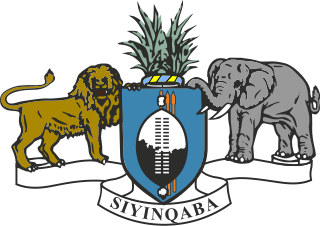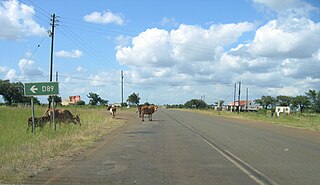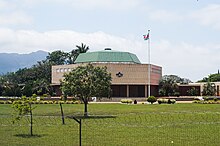
Eswatini, officially the Kingdom of Eswatini and also known by its former official name Swaziland and formerly the Kingdom of Swaziland, is a landlocked country in Southern Africa. It is bordered by Mozambique to its northeast and South Africa to its north, west, south, and southeast. At no more than 200 km (120 mi) north to south and 130 km (81 mi) east to west, Eswatini is one of the smallest countries in Africa; despite this, its climate and topography are diverse, ranging from a cool and mountainous highveld to a hot and dry lowveld.

Mbabane is a city in Eswatini, and is one of the two capitals, serving as the executive capital.

The AustralianHouse of Representatives is the lower house of the bicameral Parliament of Australia, the upper house being the Senate. Its composition and powers are set down in Chapter I of the Constitution of Australia.

Mswati III is Ngwenyama (King) of Eswatini and head of the Swazi royal family. He heads Africa’s last absolute monarchy, as he has veto power over all branches of government and is constitutionally immune from prosecution.

The Parliament of Eswatini is bicameral, consisting of a lower chamber and an upper one. Some of the members of both chambers are elected, while the rest are appointed by the King of Eswatini. Election is by secret ballot in a first-past-the-post system of voting. Members of both chambers serve for five-year terms. All candidates run on a non-partisan basis, as political parties are banned.

Lobamba is a city in Eswatini, and is one of the two capitals, serving as the legislative, traditional, spiritual, seat of government of the Parliament of Eswatini, and Ludzidzini Royal Village, the residence of Queen Ntfombi, the Queen Mother.

Big Bend is a town in eastern Eswatini, lying on the Great Usutu River (Lusutfu). Its main industry is farming and it is based mostly on sugar plantations. Big Bend is also surrounded by nature/game reserves such as Mhlosinga Nature Reserve and Nisela Safaris.

The House of Assembly of Eswatini is the lower chamber of the country's bicameral Parliament. The Assembly may debate and pass bills, although as the country is an absolute monarchy, the role of the legislature is mostly advisory.

The Senate of Eswatini is the upper chamber of the country's bicameral Parliament. The Senate may debate or pass a bill, with the exception of a "money bill", which must first be introduced in the lower chamber, the House of Assembly.
Somhlolo National Stadium is a multi-purpose stadium in Lobamba, Eswatini. Built in 1968, it has artificial turf and holds 20,000 fans. It is used for football and rugby matches.

The University of Eswatini is the national university of Eswatini.
The Diocese of Manzini is a Latin Church ecclesiastical territory or diocese of the Catholic Church in Eswatini. It is a suffragan diocese in the ecclesiastical province of the metropolitan Johannesburg in South Africa. Its episcopal see is located in the city of Manzini.
Matsapha is a town in central Eswatini. The Matsapha urban boundary is defined in the Urban Government Act of 1969, as amended in 2012, and covers an area of approximately 2,000 hectares. Matsapha was established as an industrial park in 1965 and was officially gazetted as an urban area in 1969. Matsapha is located in the Upper Middleveld of Eswatini in the Manzini region, which is in the centre of the country. Matsapha is 11 km (7 mi) from the city of Manzini, the country's commercial capital, and 35 km (22 mi) from Mbabane, the administrative capital of the country. It is well located as it is on Eswatini's main east–west axis between South Africa and Mozambique, 16 km (10 mi) from the junction of the Lavumisa road that leads to Durban and KwaZulu Natal. It lies at an altitude of 625 m (2,051 ft) above sea level.
Hawane Nature Reserve was first established in 1978 to protect an area of marsh along the Mbuluzi River in Eswatini. This area included the natural habitat of Kniphofia umbrina, a rare Eswatini endemic red hot poker. When the Hawane dam was built in 1988 to provide Mbabane's water supply, the reserve was expanded to protect the surrounding wetlands. The reserve is managed by the Swaziland National Trust Commission.
Nkhaba is an inkhundla of Eswatini, located in the Hhohho District. Its population as of the 2007 census was 15,704. Areas under Nkhaba are Jubukweni, Mhlosheni(formerly Forbes Reef) next to Malolotja Game Reserve, Hawane, Mahebedla east and west, Mnyokane, Malanti, Luvinjelweni etc. It is one of the coldest places in Eswatini.
Dvokodvweni is an inkhundla of Eswatini in the Lubombo District.
Indingilizi Gallery is an art gallery in Mbabane, Eswatini, established in 1982. Most of Eswatini's top artists have had their work showcased here. The gallery showcases a range of Swazi art including sculptures, paintings, batiks, mohair, ethnic jewellery and pottery.
The MR8 road is a major highway of Eswatini. Along with the MR3 and MR7 roads it is considered to form the "backbone of Eswatini's internal transport system." It connects the MR3 road east of Manzini at 26°29′16″S31°27′17″E with Lavumisa/Golela at 27°19′4″S31°53′18″E. It passes through the Mkhaya Game Reserve.

Dáil Éireann is the lower house, and principal chamber, of the Oireachtas, which also includes the president of Ireland and a senate called Seanad Éireann. It consists of 160 members, each known as a Teachta Dála. TDs represent 39 constituencies and are directly elected for terms not exceeding five years, on the system of proportional representation by means of the single transferable vote (PR-STV). Its powers are similar to those of lower houses under many other bicameral parliamentary systems and it is by far the dominant branch of the Oireachtas. Subject to the limits imposed by the Constitution of Ireland, it has power to pass any law it wishes, and to nominate and remove the Taoiseach. Since 1922, it has met in Leinster House in Dublin.

Lubombo is a region of Eswatini, located in the east of the country. It has an area of 5,849.11 km2 and a population of 212,531 (2017). Its administrative center is Siteki. It borders all three other regions: Hhohho to the north, Manzini to the west, and Shiselweni to the south. It is divided into 11 tinkhundla.













